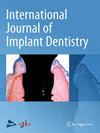用于定制牙槽嵴隆起的患者特异性β-磷酸三钙支架:病例报告
IF 3.1
3区 医学
Q1 DENTISTRY, ORAL SURGERY & MEDICINE
引用次数: 0
摘要
β-磷酸三钙(β-TCP)是一种生物相容性陶瓷材料,广泛应用于口腔再生领域。由于其优异的生物和机械性能,它越来越多地被用于牙槽嵴增量或引导骨再生(GBR)。随着计算机辅助设计和制造(CAD/CAM)技术的不断进步,β-TCP 现在可以以数字化设计的患者特异性支架的形式,在两阶段种植治疗概念中用于晚期缺损的定制骨再生(CBR)。在本病例报告中,我们遵循 CARE 病例报告指南,介绍了患者特异性 β-TCP 支架在种植前下颌骨牙槽嵴增量术中的新应用。一位 63 岁的女性患者下颌后部有明显的水平骨缺失,我们在两阶段后向计划种植治疗中使用了定制的 β-TCP 支架。支架植入九个月后进行的锥形束计算机断层扫描显示,支架与周围骨质成功融合,可以植入种植体。初次手术后两年的随访显示,口腔和种植体周围健康状况良好。该病例凸显了患者特异性β-TCP支架用于牙槽嵴增量的潜力,以及与传统技术相比的优势,包括避免异种、异体和自体移植。这些结果为其在临床实践中的应用提供了令人鼓舞的证据。对于希望在定制化骨再生手术中为患者提供安全、可预测和有效的牙槽嵴增量效果的临床医生来说,患者特异性β-TCP支架可能是一种很有前途的选择。本文章由计算机程序翻译,如有差异,请以英文原文为准。
Patient-specific beta-tricalcium phosphate scaffold for customized alveolar ridge augmentation: a case report
Beta-tricalcium phosphate (β-TCP) is a biocompatible ceramic material widely used in the field of oral regeneration. Due to its excellent biological and mechanical properties, it is increasingly utilized for alveolar ridge augmentation or guided bone regeneration (GBR). With recent advances in computer-aided design and manufacturing (CAD/CAM), β-TCP can now be used in the form of digitally designed patient-specific scaffolds for customized bone regeneration (CBR) of advanced defects in a two-stage implant therapy concept. In this case report following the CARE case report guidelines, we present a novel application of a patient-specific β-TCP scaffold in pre-implant mandibular alveolar ridge augmentation. A 63-year-old female patient with significant horizontal bone loss in the posterior mandible was treated with a custom β-TCP scaffold in the context of a two-stage backward-planned implant therapy. Cone-beam computed tomography nine months after augmentation showed successful integration of the scaffold into the surrounding bone, allowing implant placement. Follow-up until two years after initial surgery showed excellent oral and peri-implant health. This case highlights the potential of patient-specific β-TCP scaffolds for alveolar ridge augmentation and their advantage over traditional techniques, including avoidance of xeno-, allo-, and autografts. The results provide encouraging evidence for their use in clinical practice. Patient-specific β-TCP scaffolds may be a promising alternative for clinicians seeking to provide their patients with safe, predictable, and effective alveolar ridge augmentation results in customized bone regeneration procedures.
求助全文
通过发布文献求助,成功后即可免费获取论文全文。
去求助
来源期刊

International Journal of Implant Dentistry
DENTISTRY, ORAL SURGERY & MEDICINE-
CiteScore
1.70
自引率
7.40%
发文量
53
审稿时长
13 weeks
期刊介绍:
The International Journal of Implant Dentistry is a peer-reviewed open access journal published under the SpringerOpen brand. The journal is dedicated to promoting the exchange and discussion of all research areas relevant to implant dentistry in the form of systematic literature or invited reviews, prospective and retrospective clinical studies, clinical case reports, basic laboratory and animal research, and articles on material research and engineering.
 求助内容:
求助内容: 应助结果提醒方式:
应助结果提醒方式:


